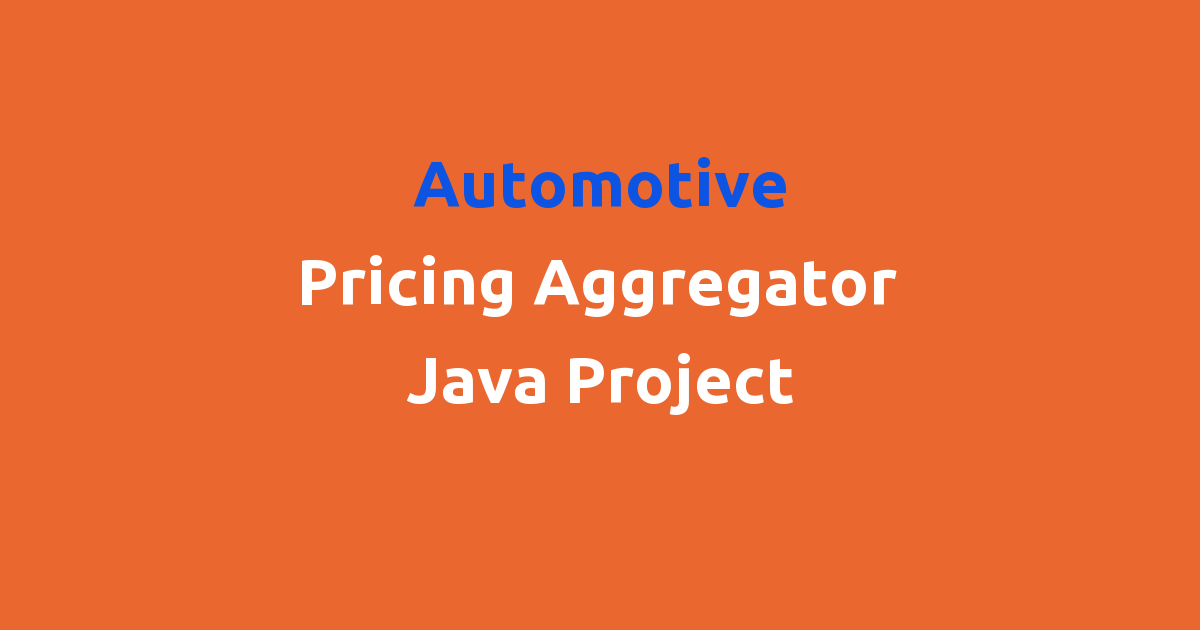Java project for compiling and comparing automotive prices.
Introduction
As a student pursuing a bachelor of technology in India, I have been working on a project focused on developing an automotive pricing aggregator using Java. This project aims to address the inefficiencies and lack of transparency in the current automotive pricing systems in the market. By leveraging the power of technology, we seek to create a platform that provides users with real-time and accurate information on car prices from various dealers. In this report, I will discuss the problem statement, the existing system, its disadvantages, the proposed system, its advantages, features, and conclude with the potential impact of our project.
Problem Statement
The current automotive pricing system is fragmented and lacks transparency. Customers often struggle to find accurate information on car prices from different dealers, leading to confusion and potential financial losses. Additionally, the process of comparing prices manually is time-consuming and inefficient. There is a need for a centralized platform that aggregates pricing data from various sources and presents it to users in a user-friendly manner.
Existing System
The existing automotive pricing system relies heavily on individual dealers and their websites. Customers have to visit multiple websites or physical stores to gather information on car prices, which can be overwhelming and prone to errors. The lack of standardization in pricing formats further complicates the process of comparison. As a result, customers often end up making suboptimal purchasing decisions.
Disadvantages of the Existing System
1. Lack of Transparency: Customers do not have access to accurate and real-time pricing information, leading to confusion and mistrust.
2. Manual Comparison: Comparing prices from different dealers is a tedious and time-consuming process that hinders informed decision-making.
3. Inefficient Process: The current system is inefficient and prone to errors, resulting in suboptimal outcomes for both customers and dealers.
4. Limited Options: Customers are limited to the pricing information provided by individual dealers, restricting their ability to explore all available options.
Proposed System
The proposed automotive pricing aggregator will address the shortcomings of the existing system by providing users with a centralized platform to compare car prices from various dealers. Our system will leverage Java programming to collect pricing data from different sources, standardize it, and present it to users in a user-friendly interface. By automating the price comparison process, we aim to empower customers to make informed decisions and facilitate fair competition among dealers.
Advantages of the Proposed System
1. Transparency: Our system will provide users with accurate and real-time pricing information, enhancing trust and confidence in the purchasing process.
2. Automated Comparison: Customers will be able to compare prices from different dealers effortlessly, saving time and reducing the risk of errors.
3. Standardization: Pricing data will be standardized across dealers, making it easier for users to compare options and make informed decisions.
4. Expanded Options: Users will have access to a wider range of pricing information, enabling them to explore all available options before making a purchase.
5. Efficiency: The automated pricing aggregation process will streamline the comparison process and improve overall efficiency for both customers and dealers.
Features of the Proposed System
1. Real-time Pricing Updates: Our system will continuously update pricing data from different dealers to ensure users have access to the most up-to-date information.
2. User-friendly Interface: The platform will be designed with a focus on usability, making it easy for customers to navigate and compare prices effectively.
3. Customized Alerts: Users will have the option to set alerts for specific vehicles or price ranges, receiving notifications when relevant pricing information becomes available.
4. Secure Transactions: The system will prioritize data security and privacy, ensuring that user information is protected during all interactions.
5. Feedback Mechanism: Users will have the opportunity to provide feedback on pricing accuracy and overall user experience, helping us improve and refine the system over time.
Conclusion
In conclusion, the development of an automotive pricing aggregator using Java has the potential to revolutionize the way customers access and compare car prices in the market. By addressing the shortcomings of the existing system and introducing automation and standardization, we aim to create a platform that empowers users to make informed decisions and promotes fair competition among dealers. Our project represents a significant step towards enhancing transparency, efficiency, and customer satisfaction in the automotive industry. Through continuous innovation and user feedback, we are confident that our system will have a positive impact on the purchasing process for both customers and dealers alike.

